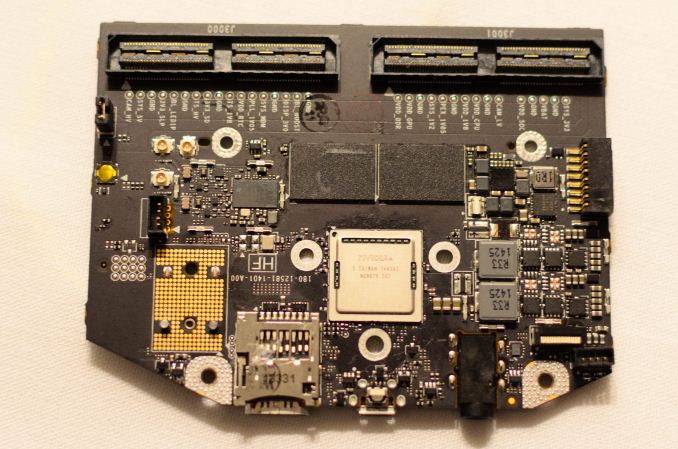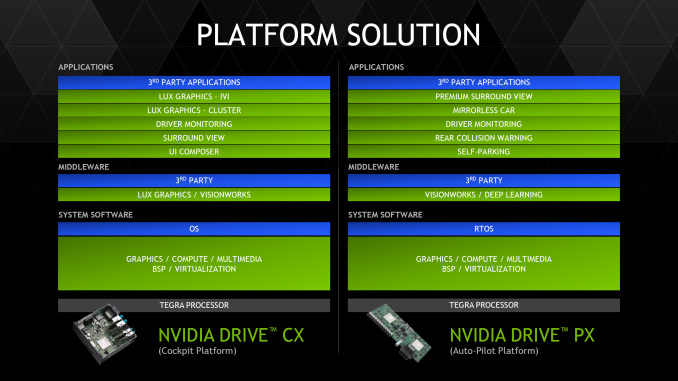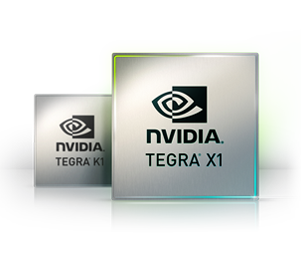NVIDIA Tegra X1 Preview & Architecture Analysis
by Joshua Ho & Ryan Smith on January 5, 2015 1:00 AM EST- Posted in
- SoCs
- Arm
- Project Denver
- Mobile
- 20nm
- GPUs
- Tablets
- NVIDIA
- Cortex A57
- Tegra X1
Final Words
With the Tegra X1, there have been a great deal of changes when compared to Tegra K1. We see a move from Cortex A15 to A57 on the main cluster, and a move from a single low power Cortex A15 to four Cortex A53s which is a significant departure from previous Tegra SoCs. However, the CPU design remains distinct from what we see in SoCs like the Exynos 5433, as NVIDIA uses a custom CPU interconnect and cluster migration instead of ARM’s CCI-400 and global task scheduling. Outside of these CPU changes, NVIDIA has done a great deal of work on the uncore, with a much faster ISP and support for new codecs at high resolution and frame rate, along with an improved memory interface and improved display output.
Outside of CPU, the GPU is a massive improvement with the move to Maxwell. The addition of double-speed FP16 support for the Tegra X1 helps to improve performance and power efficiency in applications that will utilize FP16, and in general the mobile-first focus on the architecture makes for a 2x improvement in performance per watt. While Tegra K1 set a new bar for mobile graphics for other SoC designers to target, Tegra X1 manages to raise the bar again in a big way. Given the standards support of Tegra X1, it wouldn’t be a far leap to see more extensive porting of games to a version of SHIELD Tablet with Tegra X1.
NVIDIA has also made automotive applications a huge focus in Tegra X1 in the form of DRIVE CX, a cockpit computing platform, and DRIVE PX, an autopilot platform. Given the level of integration and compute present in both DRIVE CX and PX, there seems to be a significant amount of value in NVIDIA’s solutions. However, it remains to be seen whether OEMs will widely adopt these solutions as car manufacturers can take multiple years to implement a new SoC. Compared to the 3-4 month adoption rate of an SoC in a phone or tablet, it's hard to pass any judgment on whether or not NVIDIA's automotive endeavors will be a success.
Overall, Tegra X1 represents a solid improvement over Tegra K1, and now that NVIDIA has shifted their GPU architectures to be targeted at mobile first, we’re seeing the benefits that come with such a strategy. It seems obvious that this would be a great SoC to put in a gaming tablet and a variety of other mobile devices, but it remains to be seen whether NVIDIA can get the design wins necessary to make this happen. Given that all of the high-end SoCs in the Android space will be shipping with A57 and A53 CPUs, the high-end SoC space will see significant competition once again.













194 Comments
View All Comments
stacey94 - Monday, January 5, 2015 - link
There is a massive memory bandwidth deficiency to overcome. It might have the raw processing power but it won't perform anywhere near as well.kron123456789 - Monday, January 5, 2015 - link
Well, memory bandwidth is a different story)))texasti89 - Saturday, January 10, 2015 - link
3D stacked memory and technologies like NVLINK which are expected to arrive in 2016 will the solve memory bandwidth limitations. We might very well soon see a massive 1 TB/s bandwidth on mobile SoCs. I didn't think bandwidth is the hurdle but rather the power wall which we can overcome by scaling manufacturing process.Someguyperson - Monday, January 5, 2015 - link
If you actually read the chart, the 1 TFLOP number was reached with FP16 operations and not FP32 operations, like literally EVERYONE ELSE uses. The quoted FP32 number is 0.5 TFLOPs, so it wouldn't be until 2017-18 that Tegra could actually reach the Xbox One performance without cheating the numbers.Jumangi - Monday, January 5, 2015 - link
Its doesn't need more than that for the GPU. More GPU power for a Core M is wasted for the type of products its used for. You build the chip that is balanced for the market your selling too. Why is this so beyond people who always look at every chip on the same level?LocutusEstBorg - Monday, January 5, 2015 - link
As long as it's only on the unprofitable inconsistent disaster that is Android, it's completely useless to the end user. Not a single game will be optimised for it and every game on the Play Store will continue to run like crap and crash on half the devices.They need to adopt a well managed OS like Windows Phone with proper drivers and release optimised apps on the Windows Store.
kron123456789 - Monday, January 5, 2015 - link
If they could get an x86 license it would be much better.darkich - Monday, January 5, 2015 - link
Lol, what an Android hating troll.pSupaNova - Monday, January 5, 2015 - link
If games run well on half of Android devices thats still 20x the installed user base of Windows Phone based devices.Also how many OEMs ever made a profit using Windows Phone?
tipoo - Monday, January 5, 2015 - link
Is this impression first hand? What device? Because my low end Moto G never crashes and the play store is completely smooth, more so than my iPad Mini in fact. This is a low end Android device with only Cortex A7 cores and 1GB memory backing them up.